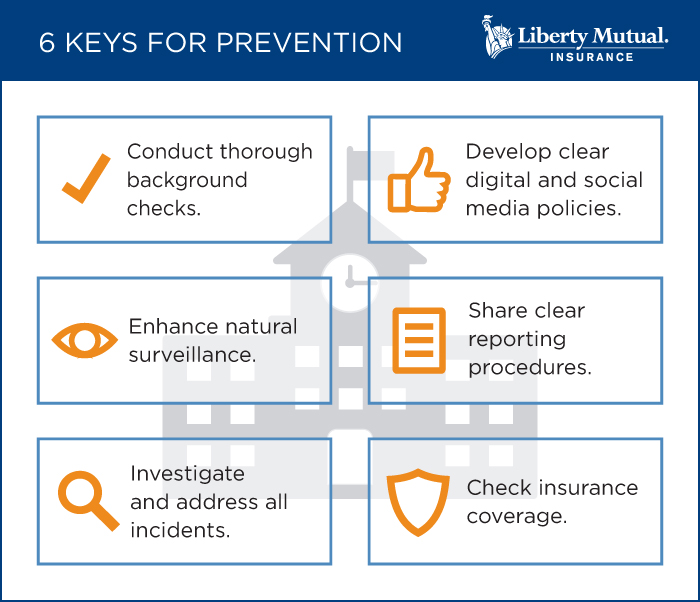Sponsored: Liberty Mutual Insurance
Protect the Vulnerable: Helping Schools Stop Sexual Misconduct

Stories of sexual impropriety have dominated headlines recently, as revelations of abuse by those in positions of power take center stage. While misconduct isn’t new, the societal spotlight is. And it has widened its scope beyond Hollywood to shine a light on sexual misconduct in athletics, workplaces, and schools.
“Today you are seeing more victims coming together, standing up and fighting back,” said Susan Kostro, Chief Underwriting Officer, Public Entities Practice, Liberty Mutual Insurance. “But one population may have a harder time finding its voice and is at significant risk for abuse: schoolchildren. “
An investigation by The Associated Press determined between 2011 and 2015, there were about 17,000 reported incidents of sexual abuse committed by fellow students in the U.S. Another report by The Boston Globe found that, since 1991, at least 67 New England private schools have fielded accusations that staffers sexually abused or harassed more than 200 students, resulting in at least 90 lawsuits.
“Schools are charged with providing a safe environment for students. When they fail, the consequences are severe,” said Steve Deig, Technical Director of Risk Control Services, Liberty Mutual Insurance. In addition to being responsible for the physical and emotional wellbeing of its students, schools must also protect their reputations and bottom lines.
To protect their students and themselves, schools need to understand their exposures to potential sexual misconduct, how to mitigate those risks, and how to respond if allegations arise.
Identifying the Exposure
There are two types of sexual misconduct and molestation (SMM) most common to the school environment — student against student, and staff against student.
“In either situation, the victims are usually among the most vulnerable — the youngest students and sometimes, those with disabilities,” Kostro said. “In other words, the students that need guidance and protection the most.”
Misconduct can take many forms, including staring or leering, suggestive gestures, “accidental” physical contact, bullying, sexual jokes or gossip, and outright offers or requests for sexual favors. The prevalence of smartphones, social media and texting makes it ever more difficult to identify when these actions are taking place. By going online, sexual predators can more easily take their behavior out of a public setting and away from the watchful eyes of peers, administrators, and parents.
“There are a lot more wrinkles compared to 10 to 15 years ago,” Deig said. “Today, educators use technology such as texting and social media professionally, but it also opens the door for inappropriate contact with students. And monitoring digital communications and enforcing safe school policies can often be problematic for districts.”
In addressing other exposures, schools may inadvertently increase the risk for sexual misconduct. For instance, to protect staff and students against an active shooter, many schools permanently cover interior classroom doors and windows to minimize a potential shooter’s line of sight—even when a school is not undergoing an active shooter drill.
“But you can’t supervise what you can’t see,” Kostro said. By reducing visibility, schools may create opportunities for inappropriate one-on-one student/staff encounters, or horseplay and potential violence among unsupervised students if windows and doors remain covered after a drill.

Mitigating the Risk
The best approach to minimizing the risk of sexual misconduct is to be proactive and remove opportunities in the first place.
Keeping windows clear is a start. Having monitors walk the halls — checking empty classrooms, stairwells, cafeterias, parking lots, and recreational fields — also helps to increase natural surveillance and curtail any chance of improper behavior. Social media and technology policies can also delineate what are considered appropriate channels and types of communication between teachers and students.
But it all begins with thorough effective screening and hiring practices for not only staff but also volunteers to keep predators out of schools to begin with.
“One of the big problems we see is that some schools do not conduct background checks consistently,” Kostro said. “You want to do everything that the law allows you to do in terms of applicant screening. The bar for what is considered the appropriate level of due diligence has gone up. What was adequate 10 years ago is not enough today.”
As liability increases, so have claim settlements.
“If allegations are brought against a school accusing it of negligent hiring, improper training and supervision, failure to report, negligent retention—consequences can reach into the millions of dollars,” she said.
In addition to stringent screening and hiring practices, schools need clear incident-reporting policies that align with state and local regulations.
“Every jurisdiction has a different definition of child sexual abuse and different reporting rules,” Deig said. “The laws are designed to over-report. If you fail to report an incident in a timely manner, there could be repercussions against the school and individual in both civil and criminal courts.”
All members of faculty and staff should be trained not only on school policies that can affect child sexual abuse but also on jurisdictional requirements so they know how to identify improper behavior and what to do about it. Some may be hesitant to report potential abuse based on a gut feeling or suspicion, so a well-defined reporting method is critical for policies to be effective.
“Don’t take allegations lightly,” Kostro said. “Err on the side of the safety of the student. Investigate every claim and report every allegation or suspicion of abuse. By taking action in good faith, school officials are helping to protect students and can help build a defensible position should there be a claim.”
But even the most careful institution can’t prevent every incident. To that end, it’s imperative for schools to check their insurance coverage.
Pinpoint the Right Insurance Partner

Sexual misconduct and molestation (SMM) coverages vary from carrier to carrier, so it’s important to partner with an insurer that knows the local legal and regulatory landscape and understands the unique exposures of schools and school districts.
Because compliance is so important, the right insurer also should be able to provide guidance to legal resources and training services.
“A lot of liability issues and exposures intertwine with sexual misconduct. While we do provide training, we can also recommend the best resources that bring in legal counsel to advise on state regulations and how to respond to specific situations. Typically, the state’s Department of Education or Department of Child Services can provide excellent school specific and state-specific training on reporting and investigation procedures,” Kostro said.
In addition to its own sexual misconduct coverage, a school should require third-party contractors who have access to and come in contact with children to hold similar policies regarding sexual misconduct exposures. Standard general liability policies may not include coverage for such claims.
“Our SMM coverage is designed specifically for schools, and our claims professionals who are dedicated to youth-serving organizations are well-versed in the exposure. The same goes for our assigned defense counsel,” Kostro said.
Liberty Mutual also provides school teacher E&O and umbrella coverage in addition to its SMM policies.
“From underwriting a product coverage to claims and defense, this is an exposure where we’ve been developing expertise since we launched the Public Entities practice,” she said.
“Through our agents and brokers, the Liberty Mutual team has the knowledge around this exposure to understand schools’ concerns, advise them on where they can limit their risk, and ultimately, help advocate for them when issues arise.”
To learn more, visit https://business.libertymutualgroup.com/business-insurance/industries/public-entity-insurance-coverage.
This article was produced by the R&I Brand Studio, a unit of the advertising department of Risk & Insurance, in collaboration with Liberty Mutual Insurance. The editorial staff of Risk & Insurance had no role in its preparation.










